« April 2009 |
Main
| June 2009 »
 May 28, 2009 | A clean mandolin is a happy mandolin
May 28, 2009 | A clean mandolin is a happy mandolin
When summer approaches and the opportunity for porch picking and festivals finally arrives, the issue of mandolin cleaning comes up. First, if you are the kind who actually covets the distressed mojo of a worn, battle-fatigued instrument, this article is not for you. Stop reading. Also, if you're the kind who doesn't see the need to take care of anything you own, one who still has the unopened nose-hair trimmer from Fathers Day (hint, hint, hint, Dad), you aren't going to have much patience or use for any of these recommendations, either. The notion that cosmetic and care translate over time into attractiveness (and resale value) will be very much lost on you.
Understand there are three kinds of elements that deteriorate an instrument's finish, and they each require a somewhat different approach to care. First, there's the human, skin oils, perspiration, saliva (gross, yeah?), and these all have different impacts base on a player's body chemistry. Some can be devastating over time, others just take an occasional wipe. The second is environmental, dust, pick micro-shavings, smoke, and will vary with the frequency and intensity of your activity. The more your mandolin is out of the case, the bigger the issue. The last is weather, humidity, temperature, all the factors of nature you need to keep in mind for not only maintaining the finish, but the larger issue of the wood itself. We'll call this last one "just say no to crack."
Like cleaning your house, the best way to keep your finish intact is to do a little, a lot. In otherwords, if you wipe your instrument every time you put our instrument back in the case (good habit!), you will have less build-up, less work to do over time. If you are using a good microfilament (or micro-fibre) cloth, you might actually never need a commercial polish.
Ever.
Old T-shirts are a bad idea. They scratch, and you may not notice at first, but over months you'll see the micro-scratches multiply. Terrycloth towels are a HUGE no no. These are ten times worse than about any fabric, and will rob the finishes luster (let alone scratch) over time.
Chamois cloths you use for drying your car are fine; really about any car care cloth is all about preventing scratches, so you can get this or cheese cloth at any auto parts store. The latter is very good for getting major build up, without harming the finish. Micro-fibre is also great, and yes, the same cloth you use for cleaning eye-glasses is perfect, albeit a tad small for your hands.
Don't forget about the less obvious parts of the instrument; besides the body, back, and sides, it's good to get under the strings and around the tuners near the strings. A cue-tip can get to those hard to reach areas, but you may not ever have to worry about that. Some will go so far as to remove all strings and oil the fingerboard. That might be a bit extreme and we'd rather change strings one course at a time and wipe prior to replacing with the new. Setting the intonation on the bridge is work, and we're lazy.
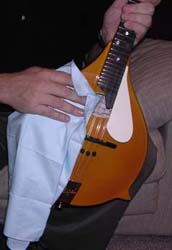 We'll put in a commercial plug for our Jupiter Silkweave cloth. You can buy microfiber locally, but if you want a perfect size cloth you can keep in your case, this is the answer to a maiden's prayer. We even have some flute players in Florida who order these in bulk for their flute students. The Silkweave cloth works great on precious metals, too. We'll put in a commercial plug for our Jupiter Silkweave cloth. You can buy microfiber locally, but if you want a perfect size cloth you can keep in your case, this is the answer to a maiden's prayer. We even have some flute players in Florida who order these in bulk for their flute students. The Silkweave cloth works great on precious metals, too.
Prepare to wipe out.
More on the Jupiter Silkweave cloth.
Further:
Keep it clean
The cold facts
This short-term investment of time will prevent build up, keep your instrument looking nice, and preserve its overall value.
Posted by Ted at 1:09 PM
 May 21, 2009 | 10,000 hours? Discipline... in moderation.
May 21, 2009 | 10,000 hours? Discipline... in moderation.
Best selling author Malcolm Gladwell author of "The Tipping Point" and "Blink," released a new book last year, "Outliers: The Story of Success." Gladwell has some fascinating theories on what it takes to become an "Outlier" the high achiever, the best, the brightest, and the most successful of people. One of them is his take on the 10,000 hours phenomenon which is especially relevant to the topic of prodigies.
He explains that in the early 1990's psychologist K. Anders Ericsson and two colleagues conducted an experiment at Berlin's "Academy of Music," where the school's violinists were divided into three groups:
1.) Stars
2.) Good performers
3.) Those who were unlikely to ever play professionally and would probably become music teachers.
These were all asked the question: "Over the course of the years, ever since you picked up a violin, how many hours have you practiced."
"All of the violinists had started playing at around age five, and they all played about two or three hours a week during the first few years. However, around the age of eight, an important difference began to emerge in the amount of hours they each practiced. By age 20, the stars in the group had all totaled 10,000 hours of practice over the course of their lives; the "good" students had totaled 8,000 hours; and the future music teachers just over 4,000 hours.
What the research suggested was that once you have enough talent to get into a top music school, the thing that distinguishes one performer from another is how hard he or she works. In addition, other studies have also shown that excellence at a complex task requires a minimum level of practice, and experts have settled on 10,000 hours as the magic number for true expertise. This is true even of people we think of as prodigies, such as Mozart."
Neurologist Daniel Levitin reports, "In study after study, of composers, basketball players, fiction writers, ice-skaters, concert pianists, chess players, master criminals, this number comes up again and again. Ten thousand hours is equivalent to roughly three hours a day, or 20 hours a week, of practice over 10 years... No one has yet found a case in which true world-class expertise was accomplished in less time. It seems that it takes the brain this long to assimilate all that it needs to know to achieve true mastery."
So where does that leave you? Don't have 10 years to practice three hours a day? Most of us in the bifocal crowd certainly don't have, unless independently wealthy. We just have to accept the fact that we aren't likely to become the next Chris Thile or Mike Marshall. That doesn't mean we can't have fun or even get better, but we need to be realistic in our outcome.
We may never be a Tiger Woods, but we can still enjoy golf. A little discipline in moderation can make us better through practice and coaching. We'll probably enjoy ourselves playing the sport as we work to get more efficient and effective. We can't however, afford to be frustrated with unrealistic goals. Balance finger-building exercises with literature, jamming, and listening, and our mandolinning will get reasonably better.
Practice scales musically. Adding some dynamics to the most remedial patterns can make them aesthetically more pleasing. After all, if you can't play scales musically, it's not likely you can play music musically! You likely don't have the time for three ours a day the next ten years; maybe even 30 minutes is a struggle. Still, make the most of practice time and enjoy yourself along the way.
Gladwell has some other interesting observations about achievers. It's a good read; if you're a regular reader here at JazzMando, you're probably the type that would enjoy this book.
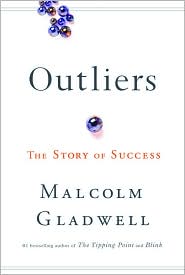
Outliers: The Story of Success by Malcolm Gladwell
Further:
Why Play?
Practice Regime; A Balanced Diet
The Joy of Mandolinning
Are you improving?
January Fitness
Posted by Ted at 7:55 AM
 May 14, 2009 | Keeping it honest: metronomes
May 14, 2009 | Keeping it honest: metronomes
A great pedagogical myth exists in regards to the importance of metronomes. It's not uncommon to refer to these time keeping devices as good for teaching you good time. The problem is this is only the tip of the iceberg. You don't just push the start button and start playing, expecting a good sense of time to wash over you. What do you do when you hit the "off" switch?
There is merit in the notion that a metronome teaches time "honesty." That's because when we play alone with no accompaniment, we get lost in the notes and technical challenges without a neutral umpire there to correct bad timing. We think we've mastered a segment, but it falls apart when played in an ensemble environment. That's why many good classically trained pianist are really lousy accompanists. They've never been challenged by a metronomical "truth."
The biggest benefit of regular metronome use is in developing optimal technique and accuracy within the context of good timing. It's a subtle difference, but the goal of developing a keen sense of time is secondary to playing with rich tone and precision. It's a simple rule of learning; if you can't play it well slow, you can't play it well fast. Trouble spots in your music, difficult licks, sloppy scale patterns, these all need to be mastered slowly, and you can't do that honestly without an effective mechanical meter.
The word "metronome" itself has a rather sterile, clinical vibe to it. This doesn't have to be that way! Let's suggest five different approaches to metronome use:
Time Keeping. The most basic use of the metronome is to take the song you're already playing and set the pace for that same tempo. Again, time "honesty" is a good thing to work for. Places that you stumble should be noted mentally, or better, with a pencil. You can go back later and attack them at a slower speed, but the metronome in its most primitive use just keeps good time for you.
Back Beat. In an ensemble situation, there are many subtle forms of the pulse going on, besides the beat itself. Listen to a good jazz performance (or even bluegrass) and you hear a healthy backbeat. It's one TWO three FOUR. Why not simulate the ensemble by setting your metronome to just hit TWO and FOUR? This can be a challenge at first, but if you have a metronome with some good sound samples, like the Seiko SQ-50 with its crisp woodblock tone, this can be a sonically appealing simulation.
Subdivision. You can double the beat (or triple) for divisions and really keep things honest. Again, in live ensemble performance, you have the subdivisions defined audibly; this is a good atmosphere to bring into personal practice time. If the song is 96 beats per minutes, set the metronome for 192.
Patterns. Some metronomes have built in patterns, like swing/shuffle subdivisions, triplets, Latin patterns, and this can be gold for really feeling a dry etude or scale challenge. The Roland TU-80 metronome/tuner has this function.
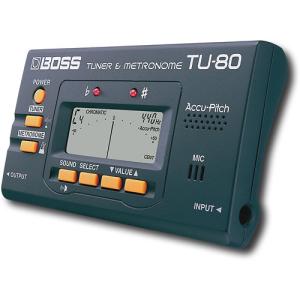
Drum machine/Accompaniment tracks. Practice can be far more engaging with a real hi hat/kick drum combination. Drum machines can be set to a different tempo, but backing tracks can be more fun. The only drawback to the latter is you can't vary the tempo. Again, you want to keep your playing "honest," playing with maximum tone and articulation accuracy.
It's about time...
Further
Swing Hard. Pick Well.
Metronome Techniques Part 1
Metronome Techniques Part 2
A look back: Sweeping for tone
Posted by Ted at 1:44 PM
 May 7, 2009 | FFcP vs Traditional Violin Positions Fingering
May 7, 2009 | FFcP vs Traditional Violin Positions Fingering
Those who come from a classical violin background (or classical mandolin for that matter) might well question the difference in approach to understanding the mandolin fretboard. We've received questions and have even noted an occasional discussion forum tackle the subject. Time to weigh in publically.
For the uninitiated, the traditional "Positions" is based on a violinist referencing all strings in relation to the "open position" where the first finger covers the equivalent of the first two half-steps (frets if there were...), second finger covers the next two, third & fourth, etc. From the mandolin fretboard equivalent each of the four fingers is responsible for the first 6 frets in open or 1st Position (I). This is a critical understanding for beginning violinists who are not only grappling with learning the vocabulary of the notes themselves, but "tuned" notes. It's hard enough learning the nuance of half and whole steps, as the player moves around the circle of keys, one discovers the magnificent world of "just tuning." Without going into a lot of whole theoretical detail here, let's just say the orchestral world is able to take advantage of "perfect" tuning, but in the piano and fretted world, we compromise with the Equal Temperament tuning. (At best, we are always theoretically playing ever so slightly out of tune.)
Beginning violinists depend heavily on the tactile understanding of the fingerboard, each finger in reference to the one before it. It's like finding your way through a dark hall with your feet. Knowing how many footsteps it is in a certain direction when you can't see can keep you from bumping into things.
Now what happens when a violinist wants to advance to higher notes? They move everything up like an elevator, but it's all referenced to the player's first finger in "Positions." The formal understanding of 2nd Position (II) is that the first finger is based on the E string, on the G string a B (or Bb).
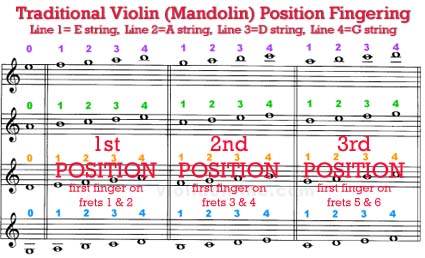
From the chart above you can see the 3rd position (III) starts everything on the equivalent of the 5th fret. Of course you've got half steps and other positions to get to eventually (IV, VI, VII), but you get the idea. Everything is referenced to a hypothetical first finger base. This is quite similar to the Don Stiernberg Ab system we've mentioned in the past.
This has worked centuries for violin pedagogy in the past, and there's no reason it shouldn't work for a mandolinist as well. Its benefits include a better understanding of the vertical nature of the fretboard (moving up the length of the string and not just across to more strings), and access to different tonal qualities of the fretboard. Orchestral instruments have a warmer tone up the string (as does the mandolin) and better expressive opportunity for vibrato.
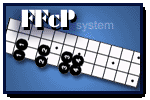 So what about FFcP? Understand the emphasis on the approach of using all four fingers as the base can give you more opportunity in a limited area of the fretboard. You also have more opportunity in shifting tonal centers not being forced to move up the fretboard just to play in a different key. Unencumbered by the need to strive for just intonation (where frequencies of notes are related by ratios of whole numbers), you aren't as tied to the fretless world of perfect tuning (for better or worse). It's also much friendlier to the horn keys of Bb, Eb and F, let alone those dark keys on the dank enharmonic equivalent end of the circle of keys, C#/Db, F#/Gb, and B/Cb. So what about FFcP? Understand the emphasis on the approach of using all four fingers as the base can give you more opportunity in a limited area of the fretboard. You also have more opportunity in shifting tonal centers not being forced to move up the fretboard just to play in a different key. Unencumbered by the need to strive for just intonation (where frequencies of notes are related by ratios of whole numbers), you aren't as tied to the fretless world of perfect tuning (for better or worse). It's also much friendlier to the horn keys of Bb, Eb and F, let alone those dark keys on the dank enharmonic equivalent end of the circle of keys, C#/Db, F#/Gb, and B/Cb.
Which is better, Positions or FFcP? This is like asking what tool is better for building a house, a hammer or a saw? Both are implements to get a different aspect of the same job done. You really need a combination of both. Limiting yourself to just one area of the fretboard in FFcP denies you rich tonal variation. Moving up the fingerboard for every key or tonal center change is hardly an efficient use of movement either, so we recommend using both.
We recommend hovering around the 3rd and 5th Positions as home base in jazz, but with a good set of FFcP skills. You can always move things back down a few frets, and occasionally, use the open string for "tricks" and covering position shifts. For a great challenge, take tunes you already know and try to base them in this area of the fretboard. This is a wonderful exercise for reading through familiar songs of the Real Book.
Further:
FFcP Index
FFcP Moving on Up
The Ab Position
Violin Online Advanced Fingering Chart 1st--7th Positions
Posted by Ted at 12:59 PM

Disclaimer: In the 'Information Age' of the 21st Century,
any fool with a computer, a modem, and an idea can
become a self-professed 'expert." This site does not
come equipped with 'discernment.'
|



